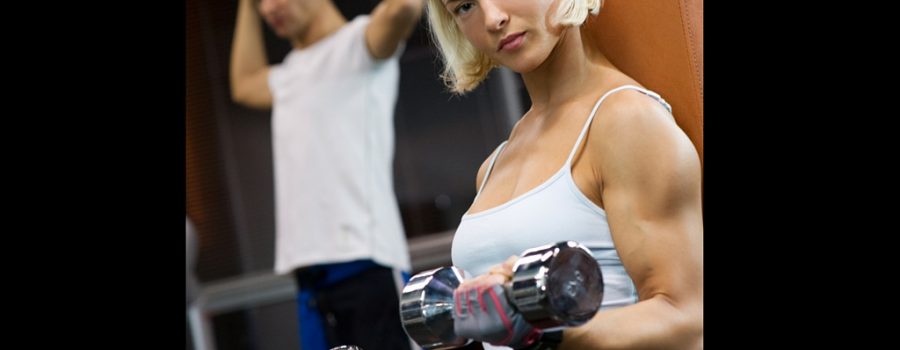In this post:
- What causes those rapid new gains post show
- Muscle memory phenomenon
- Muscle strength
- Muscle size
- Take home message
- Muscle memory phenomenon
If you have ever been laid off of training due to injury for a few months or ever competed in a bodybuilding contest having dieted down to below normal body fat levels, you are familiar with some loss in muscle size and strength. Once you start training again or you start eating more calories after that contest, noticeably rapid gains appear in the mirror.

 If you don’t know what gains are, I am talking about muscle mass. This goes for bikini, figure, and physique woman as well as physique and bodybuilding men.
If you don’t know what gains are, I am talking about muscle mass. This goes for bikini, figure, and physique woman as well as physique and bodybuilding men.
What causes those rapid gains post show?
Muscle memory phenomenon
First, lets talk about the muscle memory phenomenon and get a little skeletal muscle anatomy lesson in.
The muscle memory phenomenon shows that a previously trained person, who has taken a break up to 3 months will quickly regain the strength and muscle mass they had prior to detraining (ref 1). Lets break this into two parts; muscle strength and muscle size.
Muscle Strength
Neurological mechanisms can explain the rapid regain of strength after having had a break from your program (ref 5). Here’s how.  The neurons (aka nerve cells) tell your muscle fibers (aka muscle cells) they innervate to contract. When you lift weights, your muscles adapt to the stresses placed upon them by recruiting these muscle fibers. The heavier the weight and the longer you train, the higher the percentage of muscle fibers are recruited . Simply put, more weight on the bar, more nerves innervate more fibers, more muscle fiber stimulated. Muscle fiber types and stimulation is a whole other topic I won’t get into in this article.
The neurons (aka nerve cells) tell your muscle fibers (aka muscle cells) they innervate to contract. When you lift weights, your muscles adapt to the stresses placed upon them by recruiting these muscle fibers. The heavier the weight and the longer you train, the higher the percentage of muscle fibers are recruited . Simply put, more weight on the bar, more nerves innervate more fibers, more muscle fiber stimulated. Muscle fiber types and stimulation is a whole other topic I won’t get into in this article.
When you stop training for a period of time, usually 2-3 months or less, then start again, your muscles’ ability to recruit that greater percentage of fibers remains intact compared to the first day you had trained to start with.
Another reason for the regain of strength after a period of detraining for 2-3 months or less are neural patterns. When learning a new skill, your nervous system must develop the appropriate patterns of stimulation to perform moves like a squat or bench press. Once neural patterns are established, you are able to perform that skill automatically. If you had to take time off training, there will be some loss of neural patterns but, once you start training again, the neurological changes recur faster.
Muscle fiber recruitment and neural patterns are reasons why power lifters are able to lift so much weight without having super huge muscles.
Muscle Size
If you have ever cut calories to get super lean for a bodybuilding competition or had to take a break from training due to injury, you know about those rapid gains made once you start eating more calories after the show or you start training after a length of time off.
Even though detraining results in weaker smaller muscles, your body has a fancy dancy system in place to ensure that your muscles resist atrophy and will come back quickly when needed. Here’s how it works:
Muscle anatomy and growth:

Fig. 1
Looking at figure 1, the skeletal muscle is made up of a fixed number of fiber bundles . The fibers are long cylindrical multinucleated cells containing myofibrils. The myofibrils increase in numbers which causes muscle fibers (cells) to grow (hypertrophy). Multinucleated means each cell contains many nuclei (fig 2). Having multiple nuclei per cell is unique as very few cell types in the body have more than one nucleus. The nucleus is the command center of the cell and houses the DNA which is the blue print for protein synthesis (ref 8). Protein synthesis is essential for muscle growth.
In other words, the nuclei play a big part in the growth and repair of muscle tissue and its continued function(ref 6,8 ).
(Good gawd Heather will you just get to the point!)
okay, okay, I am getting there….. here you go:
Muscle fibers adapt to stress placed upon it by repairing the micro tears to the myofibrils caused by training, forming new myrofibrils as well as new nuclei all utilizing the protein synthesis blueprints from the 100’s of nuclei within a muscle fiber (simply put, skipping satellite cell step). With continued training and proper diet, the nuclei synthesize new muscle proteins and viola, the muscle fiber gets larger!
BOOM!
^^^ LOL, I crack me up ^^^
Detraining:
Now, say you injure yourself and can’t lift for 6-8 weeks, or, you cut for a bodybuilding show as a natural athlete and inevitably lose muscle due to being in a caloric deficit while pumping iron and HIIT’ing that treadmill (ref 2,9).
Never fear! When the aforementioned scenario’s takes place, the muscles are actually resistant to shrinkage (aka atrophy) due to the fabulous increase in the number of nuclei you acquired from all that strength training you did. And, when protein degradation does occur where there is a loss in size and number of myofibrils, the nuclei remain (ref 2,3,4,8) !!!!
What’s the big deal about increased nuclei?
What’s the big deal? I worked so hard to build those myofibrils to only have lost a bunch!? Not really….once you are back in the game and protein synthesis exceeds protein degradation due to more calories eaten and/ or training begins again, muscle fibers can rapidly increase back to (or darn near) original size because time and energy isn’t wasted on forming new nuclei, they are already there ready to get to work!
Take home message
The more you stress your muscle by lifting, sprinting, doing what ever it is you do in beast mode, more nuclei are added to the muscle cell and muscle cell size increases.The bigger and more used the muscle fiber, the more nuclei. The more nuclei, the more resistant your muscles are to atrophy when not training (up to 3 months) or when training in a caloric deficit for a period of time. If you have lost muscle, never fear, it will come back to full or near previous capacity at a much faster rate than when you had initially worked so hard to put in on!
See also:
References
2) Jackman RW, Kandarian SC. The molecular basis of skeletal muscle atrophy. Am J Physiol Cell Physiol. 2004 Oct;287(4):C834-43.
3) J. C. Bruusgaard et al. Myonuclei acquired by overload exercise precede hypertrophy and are not lost on detraining Proc Natl Acad Sci U S A. 2010 Aug 24;107(34):15111-6. doi: 10.1073/pnas.0913935107. Epub 2010 Aug 16.
4) Gundersen K, Bruusgaard JC. Nuclear domains during muscle atrophy: nuclei lost or paradigm lost? J Physiol. 2008 Jun 1;586(Pt 11):2675-81. doi: 10.1113/jphysiol.2008.154369. Epub 2008 Apr 25.
5) Rutherford OM, Jones DA. The role of learning and coordination in strength training. Eur J Appl Physiol Occup Physiol. 1986;55(1):100-5.
6) Bruusgaard JC et al. Number and spatial distribution of nuclei in the muscle fibres of normal mice studied in vivo. J Physiol. 2003 Sep 1;551(Pt 2):467-78. Epub 2003 Jun 17.
7) Hortobágyi T et al.The effects of detraining on power athletes. Med Sci Sports Exerc. 1993 Aug;25(8):929-35.
8) Gundersen K. Excitation-transcription coupling in skeletal muscle: the molecular pathways of exercise. Biol Rev Camb Philos Soc. 2011 Aug;86(3):564-600. doi: 10.1111/j.1469-185X.2010.00161.x. Epub 2010 Oct 6.
9) John W. Carbone et al.Skeletal Muscle Responses to Negative Energy Balance: Effects of Dietary Protein









5 Comments
Leave your reply.